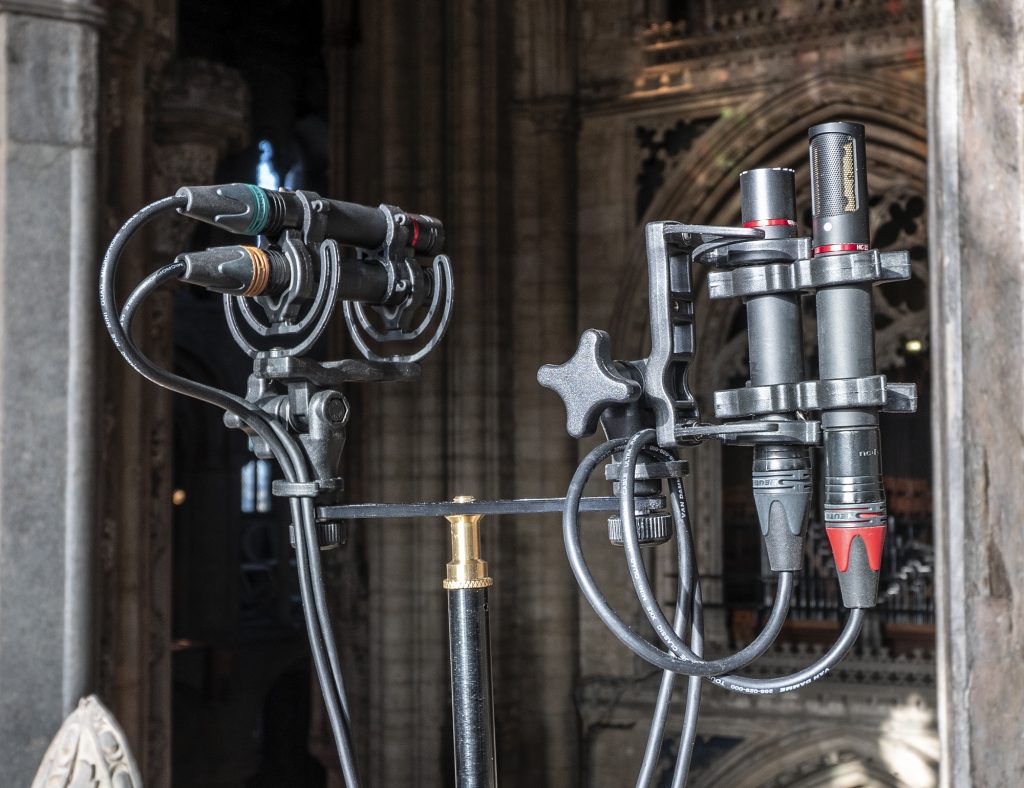
Introduction
For anyone who has been following the foray of long-established and respected maker of mic windshields and suspensions, Rycote, into manufacture of mics themselves, the announcement of the BD-10 fig 8 at NAB 2023 is an exciting development. With two shotgun mics produced in 2021 and then, in 2022, omni, cardioid and supercardioid mics, a fig 8 mic was undoubtedly the most hoped-for mic to give a reasonably complete range. You might wish for a wide cardioid too (or variations on the existing polar patterns – a free-field omni mic, for example), but there is no doubt that a fig 8 mic is vital to Rycote’s range of mics for several reasons: first, Rycote’s established customer base is founded on field recording and, especially, those recording sound for film/television, where mid-side recording – and a fig 8 mic – is a key tool; and, second, the company needs a full range if it is to tempt users away from more established manufacturers. That there are few such complete ranges, with a fig 8 mic in the sub-£1000*mic category adds to the significance of the BD-10: with the recent demise of AKG’s competent Blueline mics (launched 30 years ago), I can’t think of another manufacturer producing mid-priced SDC mics with a fig 8 in the line-up other than boutique Taiwanese mic-maker B9Audio (with almost no reviews and mics only available direct from a private address in Taipei, B9Audio is not viable for most) and, possibly, respected German manufacturer MBHO (I say possibly, since the MBHO website has long since failed to list the KA 800 fig 8 capsule, pricing is uncertain, and, again, distribution is not similar to most mainstream mic manufacturers: for example, I can’t find any MBHO mics in stock in the UK). And one-off SDC fig 8 mics (i.e. not forming part of a range of polar patterns) in this category are rare too. Perhaps more surprisingly, not all mic manufacturers producing SDCs in higher price brackets have succeeded in producing a fig 8: most obviously, Sennheiser has never managed to bring a much-anticipated MKH8000 series fig 8 to market (although the excellent, albeit large for an SDC mic, MKH30 has remained in production since launched in 1987), and DPA similarly has no SDC fig 8 offering.
*NB: though Rycote has yet to announce pricing, it will almost certainly be in this category, but perhaps a little pricier than its £670 SDC siblings. UPDATE 1 Feb 2024: the BD-10 is now being listed in several respected stores here in the UK, most with a price of £638 (inc. VAT), and nothing higher than this. I’ve even noticed some MS kit deals – BD-10, super-cardioid SC-08 and Cyclone windshield for £1500 (inc. VAT). So, it looks very much to be good news on the pricing.
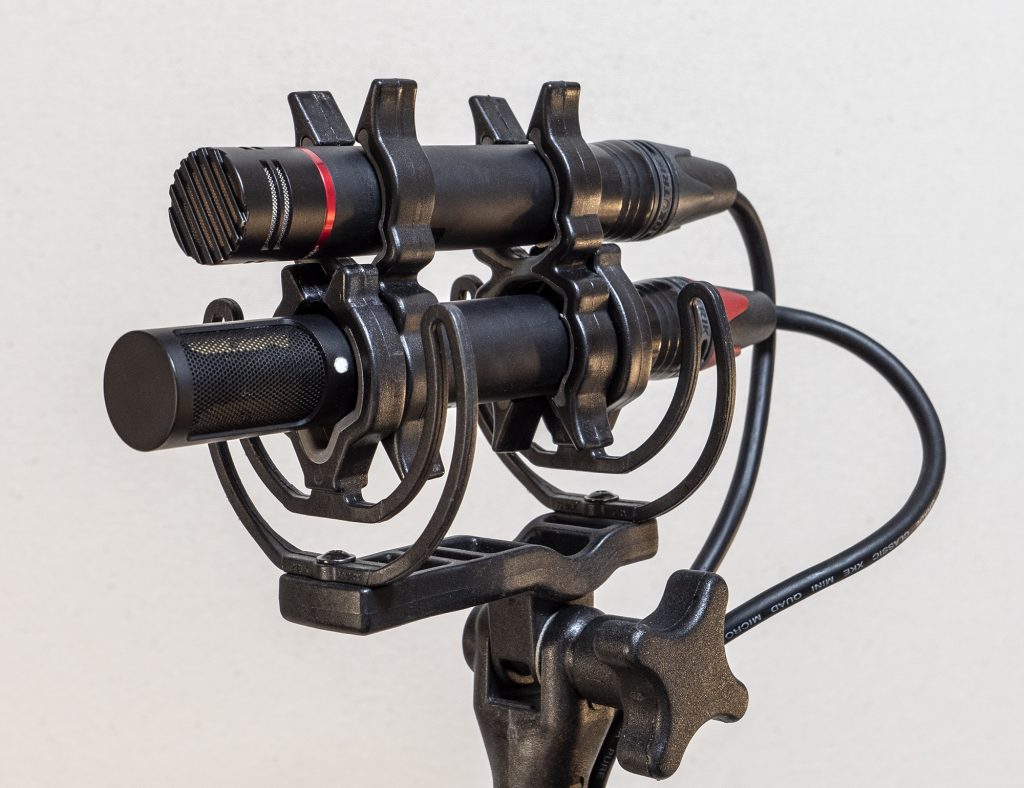
The Rycote BD-10, on paper, then looks like it will be a welcome addition to the market, when it becomes available (probably not until the autumn). Its self-noise is comparable to that of the Schoeps MK8. It is a little (22mm) longer and heavier (15g) than Rycote’s omni, cardioid and supercardioid mics, but not radically so. This reflects the capsule design, which, I understand, is a pairing of 11mm diameter diaphragms one above the other with a waveguide to blend them: the polar pattern graph shows a very symmetrical result from this arrangement, but, of course, the proof of the pudding is in the eating. So, what is the mic like in reality? On to some field tests and trials.
NB The mic tested was a prototype, and the final specs of the BD-10 in production may differ slightly.
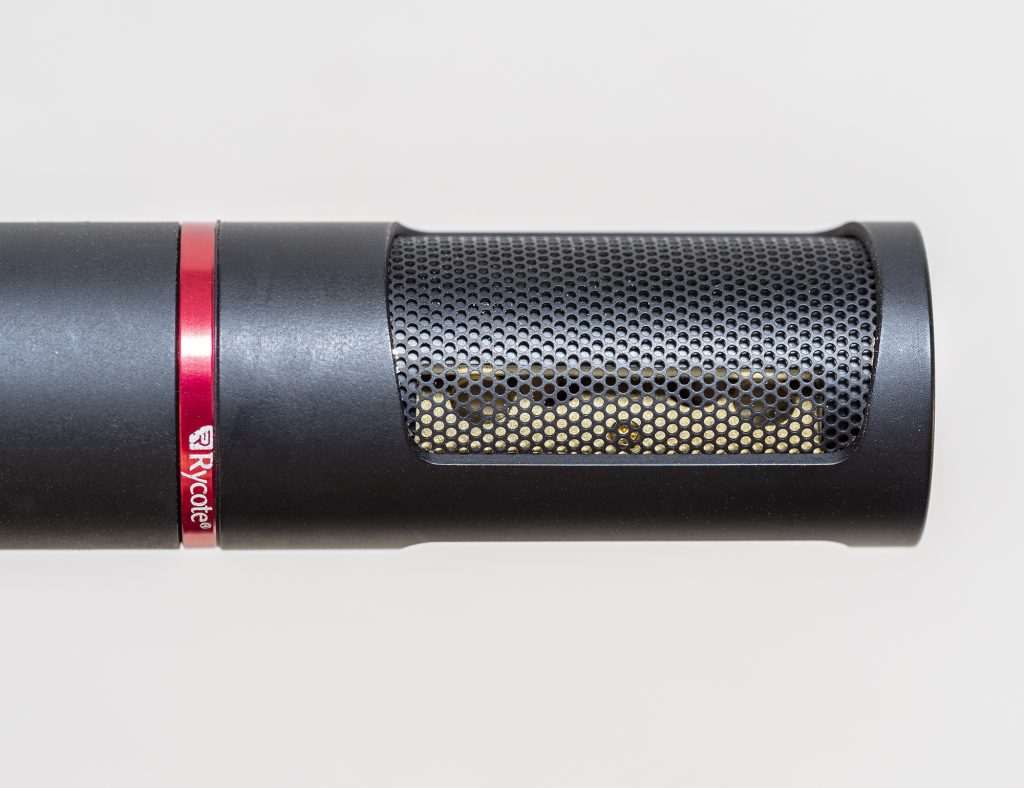
RFI
As with all mics, I was interested in the impact of radio frequency interference (RFI) on the BD-10. Living in rural Norfolk, much of my life is outside or on the edge of mobile phone reception, where some models of phones transmitting at full power can cause notable interference on mics at up to, say 1m/3ft: not a problem with mics on a stand, but I’ve had this become a real issue with handheld shotgun mics and a phone in my jacket pocket (on those rare occasions when I forget to turn my phone off). And this could be a problem with ENG work too (not least from the phone of an interviewee). So I was glad to find that in testing, as before, with several different phones on the absolute fringe of reception (i.e. working at highest power) the mic showed no sign of RFI even at close distances (100mm): the other Rycote mics are similarly resistant to RFI.
Self-noise and sensitivity
With an 18dBA self-noise figure the BD-10 has significantly more self-noise than its stablemates, which are the HC-15 and HC-22 shotguns at 8.5dBA; the omni OM-08 at 11dBA; the supercardioid SC-08 at 12dBA; and the cardioid CA-08 at 13dBA. The previously released Rycote mics, however, have unusually low self-noise, and higher self-noise for SDC fig 8 mics is normal. For example, at 17dBA the Schoeps MK8 has a very similar self-noise figure to the Rycote fig 8, and, again, 7dBA more than its MK 2 omni capsule counterpart (10dBA). In short, the BD-10 is in good company and 18dBA self-noise for a fig 8 is respectable.
A check on the reality of the 18dBA figure – by recording the sound of nothing (the mic buried deep in duvets in the airing cupboard, with all doors and windows closed and the mains electricity turned off, recording into a Sound Devices MixPre-3 [EIN -130dBV/-128dBu]) and with reference to other mics – confirmed that the self-noise is indeed around that stated.
Testing this in the real world, I rigged the BD-10 as an MS pair with a cardioid CA-08, and a second SDC fig 8 in the form of the AKG CK94: the latter, although just discontinued, is a rare example of another sub-£1000 SDC fig 8 mic with a full frequency range.
First off, recording the ambient sound of my nominally quiet Norfolk village street (yet again!) even in the quieter parts there is no evident difference between the two Rycote mics, but hiss from the AKG CK94 is clearly discernible, which reflects its 22dBA self-noise spec.
Turning to a quieter environment, it was useful to test the BD-10 indoors, in this case with some sound effects/indoor ambience: the mic was set up as a mid-side pair with the cardioid CA-08 in the middle of the kitchen, with various household noises – and some silence – recorded. The AKG CK94 was also paired with the CA-08 for comparison. Here are the two MS tracks and then the three iso tracks for the cardioid mic and the two fig 8 mics:
During the sounds such as cutlery being placed in a drawer the two fig 8 mics are both very usable, but in the quiet passages, such as near the end, the hiss of the AKG CK94 is, again, fairly evident.
The specs state the BD-10’s sensitivity as 14.2mV/Pa (-36.95 dBV). This means that the BD-10 is the least sensitive of the Rycote mics (the next being the cardioid at 24.3 mV/Pa or -32.3 dBV), but its output is still healthy. For example, it is more sensitive than the Schoeps MK8 (12 mV/Pa or -38.5 dBV) and the AKG CK94 (10mV/Pa or -40 dBV). A consequence of this is that the BD-10 has a couple more dB max SPL than its stablemates, but the more practical reason for being aware of its sensitivity is for level matching against different mics when using the BD-10 in an MS pair (matching sensitivity in the recorder in such use giving an easier starting point for monitoring and in post).
Frequency response and ‘sonic signature’
Fig 8 mics generally have a poorer bass response, although some, such as the Sennheiser MKH30 are exceptions: in this case pretty much flat down to 40Hz. The main competitor pricewise to the BD-10, the Ambient Emesser ATE 308, has a marked bass roll-off from 100Hz (if not higher), which is fine if matching for MS to a shotgun mic that has a similar roll-off, but is not ideal for other use. More surprisingly the much-loved Schoeps MK8 has a steady fall off starting from above 200Hz, and, according to its frequency response graph, is down 8dB by 50Hz: at the high end there is a sudden fall-off from 16kHz, so that the response is down by 20dB at 20kHz. The more modestly priced AKG CK94 has a less curtailed frequency response than most of these examples (bar the MKH30) being down about 3.5dB at 50Hz and a similar amount at 15kHz (with no published data beyond). On paper, the Rycote BD-10 looks hopeful: the frequency response graph shows a very gradual roll-off from 200Hz so that it is only -1dB at 100Hz, -2.5dB at 50Hz, and -4dB at 20Hz. If the graphs are correct, then this suggests, a little surprisingly, that the BD-10 has a better bass response than the cardioid CA-08 and supercardioid CS-08. At the upper end, after a little rise around 12kHz, the BD-10 is down about 5dB at 20kHz.
So much for the theory: now to reality! First, a different take on the ambient recording, in this case with the two fig 8 mics (i.e. Rycote BD-10 and AKG CK94) oriented so that in each case one of their lobes faced the rear of a parked car and, in a separate blimp, the SC-08 cardioid likewise facing the car, which was then started. The resulting mono tracks show all three mics capable of rendering the lowest fundamental (at the lowest engine idling speed around 24Hz), with the BD-10 showing more low frequency response than the AKG CK94, but slightly less than the cardioid CA-08: this isn’t a surprise in terms of an expectation of a fig 8 mic versus a cardioid, although it is not what would be anticipated from the frequency response graphs. Graphs aside, though, it is clear that the BD-10 has a good bass response for a fig 8 mic, which suggests good capability for, say, music recording or effects and field recording with a bass component.
At the upper end, it was interesting to see if the BD-10 had any of the extended high-frequency response found in testing of the other Rycote SDC mics. As with the comparison of the Rycote OM-08 and Sennheiser MKH8020 omni mics for extended high frequency response, I recorded a street ambience at 96kHz instead of 48kHz, in this case including the OM-08 and the AKG CK94 alongside the BD-10 for comparison, with levels adjusted to reflect the different sensitivities. As with the omni mics comparison, again the spectrograms are revealing: they show the extended high-frequency response of the omni OM-08, as now expected, with, for example, the gate latch-shutting sound (that tall spike near the right-hand side of the spectrograms) reaching about 48kHz, and the wider spike of the passing tractor (towards the left-hand side of the spectrograms) reaching around 35kHz, and, as would be expected, with much more low-frequency content. The BD-10 shows both clearly, showing that the different capsule design for the fig 8 mic still has a very respectable extended high-frequency response to near 48kHz: moreover, the BD-10 is like the OM-08 in that it is consistently low in terms of self-noise up to the top of the graph (around -136dB at 48kHz) in stark contrast to the previous comparison of the OM-08 and Sennheiser MKH 8020 (where the Sennheiser had considerable self-noise in the extended high frequency range, although not, of course, in the human audible range). The AKG CK94 has a rather lower extended high frequency response, although rather better than anticipated from previous tests on the other Blueline capsules, and has a little more self-noise at such frequencies (as, of course, it does in the audible range). As discussed previously, extended high-frequency response might seem entirely academic outside those recording at high sample rates and pitching down in post (e.g. for bat recordings, or for sound effects), but there are those that argue frequency response over 20kHz is important for high-resolution recording (such as David Blackmer of Earthworks mics in this article). If so minded, there is no doubt that the Rycote fig 8 is a respectable performer over 20kHz, comparable to the other Rycote SDC mics, and with much lower self-noise a useful benefit of the not quite as far extended high-frequency range as found in the Sennheiser MKH 8000 series mics.
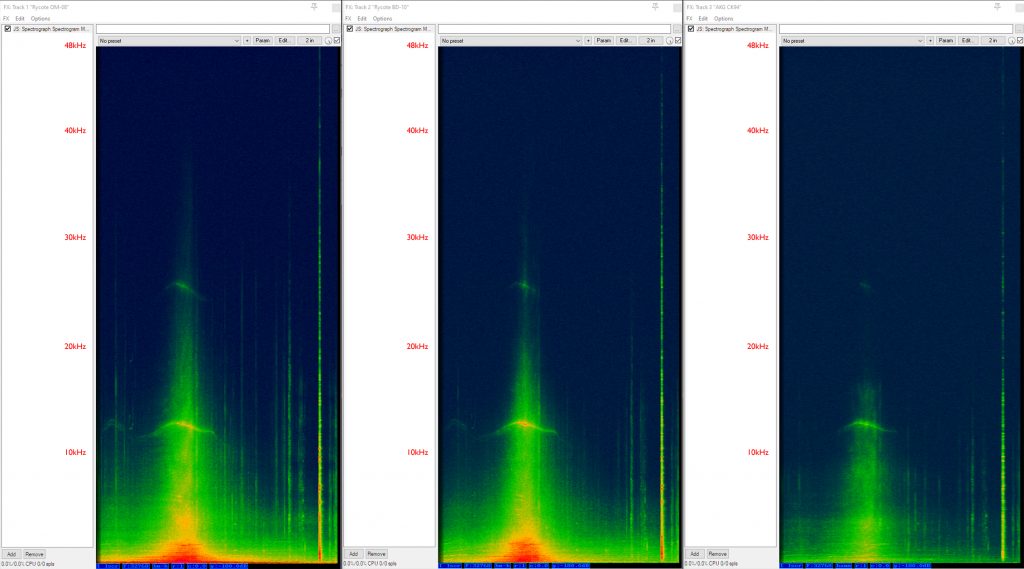
Putting this good low and high-frequency response to practical use, I tested the BD-10 on a guitar to cover a wider frequency range. At the same time, given that the previously produced Rycote mics are described by the manufacturer as having ‘a tonal and sonic signature that makes them cut together seamlessly’ and that this relates to frequency response, I also included the omni, cardioid and supercardioid mics in this test, placing mics at the relevant increasing distances to allow for their different polar patterns to reduce the impact of different reflections: the omni mic was placed at 400mm, the cardioid and fig 8 at 680mm (distance factor of 1.7) and the supercardioid at 760mm (distance factor of 1.9). To make comparison most straightforward the wav file has a single strum from each mic in turn (omni, cardioid, fig 8 and supercardioid in turn), followed by a short space and repeated another three times. This was carried out in a normally furnished living room, with a low ceiling.
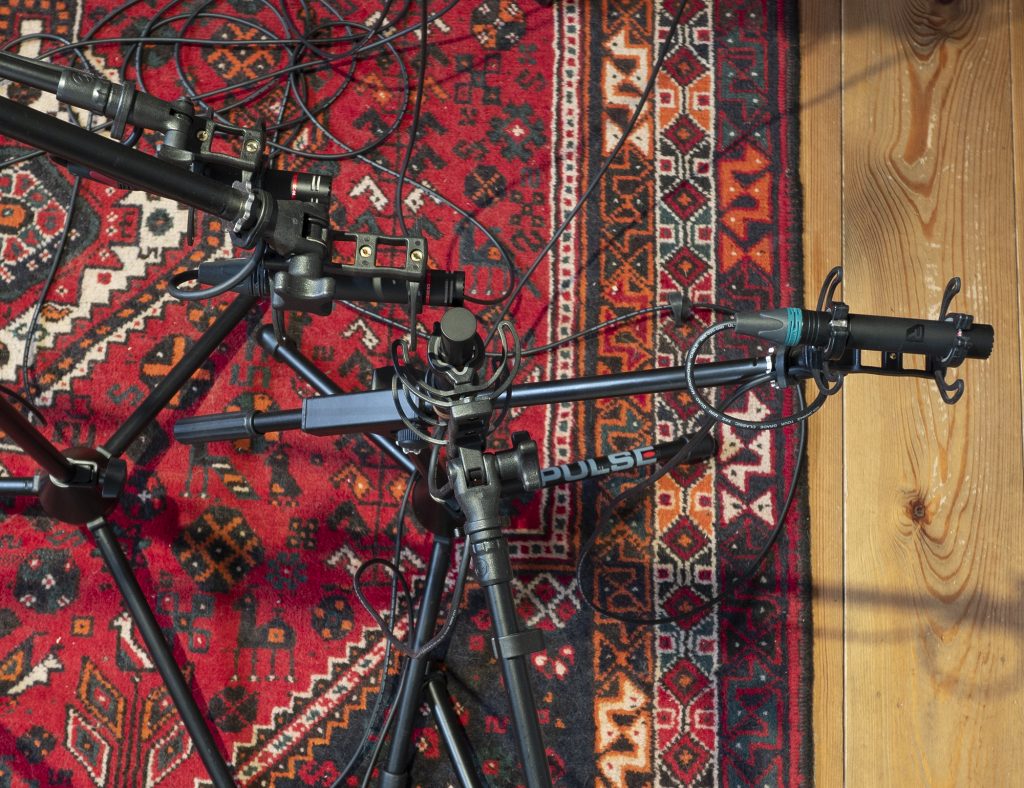
It is hard to draw definitive conclusions from this simple test. Matching levels was extraordinarily difficult given the different frequency content and different reflections resulting from the different polar patterns, distances and frequency responses: in the end I settled for calculating the impact of the differences of distance and sensitivity. There is, as would be expected, a slight change in the sound as the polar patterns and distances change, and, despite being at the same distance, there is a difference between the fig 8 and the cardioid mic: to a significant degree this is the impact of the greater bass response of the cardioid. Interestingly, the fig 8 and the supercardioid have a very similar sound, doubtless reflecting the reduced bass response of the latter (and, of course, its greater distance: less proximity effect). In short, though, the ‘sonic signature’ for the mics is close enough that I wouldn’t hesitate in using the BD-10 with any of the other mics in a mid-side or double mid-side array.
Handling noise
The BD-10 will have a wide range of applications, but this is likely to include use on a boompole in a MS or DMS rig, so handling noise performance is relevant: all other things being equal, fig 8 mics are the most susceptible to handling noise. Testing for handling noise transmitted via a boompole involved some deliberately clumsy booming, aiming for transmission of vibration to the mics. Three mics were included in the test (i.e. rigged together on a Rycote Invision suspension with back-to-back clips) to allow comparison: the Rycote BD-10, the Rycote SC-08 (supercardioid) and the AKG CK94 (fig 8). Gain levels were adjusted for relative sensitivities.
When holding the boompole still only the BD-10 showed any significant handling noise, which peaked at -38dB, with LUFs at -68.7dB. Evidently this was trembling/vibration from the boom operator’s muscles holding a steady stance, and was all low-frequency energy below c.35Hz: a high-pass filter – a pretty essential adjunct to booming – removes such energy. In the second recording of boompole handling an 80Hz high-pass filter was applied and the low-frequency content in the BD-10 recording is absent: in this case, however, some medium clumsy handling transmits more to the mic than to either the SC-08 or the CK94, which perform very similarly (about 10dB lower noise in terms of LUFs compared to the BD-10). In the third boompole handling test, with extreme rough handling – rather implausibly so! – the difference between the BD-10 and the other two mics remains similar at around 10dB. While previous tests against the AKG CK93 and Oktava MK012 hypercardioids revealed the SC-08’s ability to cope with handling noise rather better, it is clear that the BD-10 doesn’t perform as well as its stablemate or, indeed, the AKG CK94 fig 8, but, other than that sub-c.35Hz transmission – which can be easily cut off by use of a high-pass filter at 40Hz or above – it should offer no problem to the user given a suitable suspension and experienced boom operation (not forgetting that capture of stereo ambiences on a boompole is usually for incidental B-roll, camera perspective stereo etc., not whilst executing complex and rapid boompole movements for dialogue recording!).
Wind noise
Fig 8 mics are especially susceptible to wind noise, so it is interesting to explore this aspect of the BD-10’s performance. To get a base line, a triple rig of BD-10, SC-08 and AKG CK94 was used again, this time, however, with the mics in separate Invision suspensions, spaced along a stereo bar so that no mic was shielded from the wind by the others, and mounted on a boom pole. Fast boom swings were made to generate wind noise, not to represent typical usage of a fig 8. Gain was set as for the handling noise tests (see above). Swinging the bare mics produced overwhelming rumble, as would be expected: the SC-08 and BD-10 performed very similarly, while the AKG CK94 performed rather better (about 13dB better in terms of peak and LUFs). Of course, such use is unrealistic: even with a modest amount of boom movement indoors (or the gentlest air movement around a static mic indoors) at the very least a foam windshield would be used, so the test was repeated with the manufacturer’s original foams on all three mics. Again, the two Rycote mics produced similar levels of wind noise, with the AKG CK94 maintaining an advantage of around 13-15dB. Applying an 80Hz high-pass filter on the recorder in the third test evened things up rather, with wind noise much reduced and with the AKG CK94 having around a (reduced) 5dB advantage over the two Rycote mics. As was noted in the previous SC-08 wind tests against the AKG CK93 and Oktava MK012, it performed between these two mics in terms of noise and, in extensive use since, has not proved problematic. That the BD-10 performs similarly, despite its fig 8 pattern, is reassuring: of course, better wind (and handling) performance at the level of the CK94 would be welcome, but there is no reason to think that the BD-10 isn’t suited to use in wind given, as with any mic, suitable wind protection for the use and conditions.
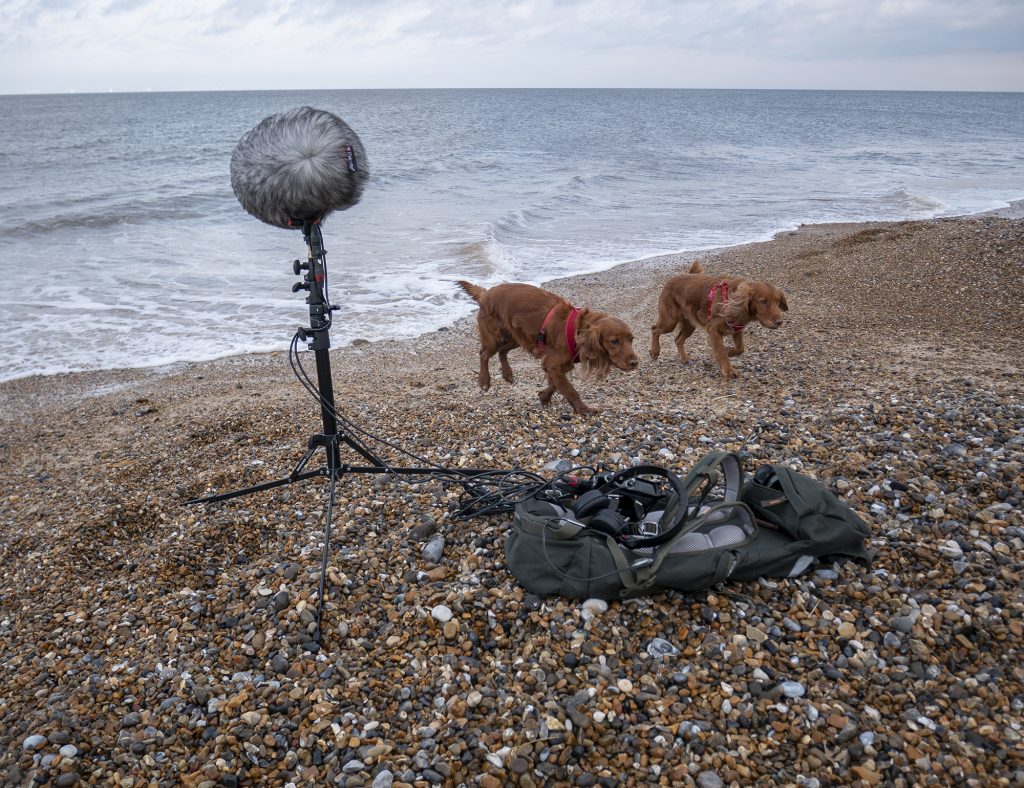
Following up on this and placing the mic in high wind for an ambient recording confirmed this. I took a mid-side rig with the SC-08 and BD-10 mics in a medium Cyclone windshield up to the north-facing Norfolk coast on a windy day (about 20 mph or more), recording in one location on the inland side of the shingle spit, facing westwards into the wind (including some walking nearby on the shingle), and in a second location on the beach (the wind coming from slightly rear of the left-hand side of the Cyclone). Finally, back in the garden with the same rig and with the wind still blowing (but inevitably not as hard as at the coast), I then did a further recording. For the recordings, I include the individual SC-08 and BD-10 isos, along with the decoded MS and then the latter with an 80Hz high-pass/low-cut filter applied.
It is always hard to translate and communicate conditions let alone those in high wind. In none of these cases would I have attempted a nature/ambience recording as set-up for these tests: I would have sought some shelter from the direct blast of the wind (e.g. in the lee of the pillbox on the beach, or in the lee of the garden wall), not least to reduce vibration of the mic stand. But what the tests do confirm is that the BD-10 is in the same ballpark in terms of wind noise as, say, its supercardioid counterpart. In short, I’d have no hesitation using the Rycote fig 8 for outdoor field recording.
A bit of music
I recently wrote a blog post about a simple video of a singer-songwriter (Lucy Grubb), for a competition entry, and, though I mentioned use of a variation of double mid-side recording, I skipped over just what fig 8 mic I was using. As it is no longer under wraps, it is good to be able to clarify that I used the new BD-10 alongside its supercardioid (SC-08) and cardioid (CA-08) stablemates. Using the three mics, the fig 8 was set conventionally pointed at Lucy, just above the top of her guitar, so that its lobes faced left and right; immediately below this the supercardioid pointed upwards to capture the vocals, and immediately above the fig 8 the cardioid pointed downwards to the guitar – aimed around the 12th fret.
Conclusions
When Rycote followed up on its initial two shotgun mics of 2021 with its omni, cardioid and supercardioid mics the following year, this gave real hope that a fig 8 might follow. Evidently, the capsule design is very different to that used in the other mics, so all the more credit should go to Rycote for persisting. As I said at the outset, a fig 8 is critical to the use of so many recordists that use Rycote’s windshields and shockmounts; and it is important if Rycote wants to be seen as a real contender as a mic manufacturer. That Rycote has come up with a fig 8, and fairly quickly, is good news: that it performs so competently means that it is a great counterpart to the rest of the range. Over a couple of months (intermittently) testing the mic, I have been impressed: I will, however, continue to work with it, not least putting it through its paces on more musical sources, and more field recording.
Update 10.10.2023: see separate post on using a pair of BD-10s for a Blumlein recording.


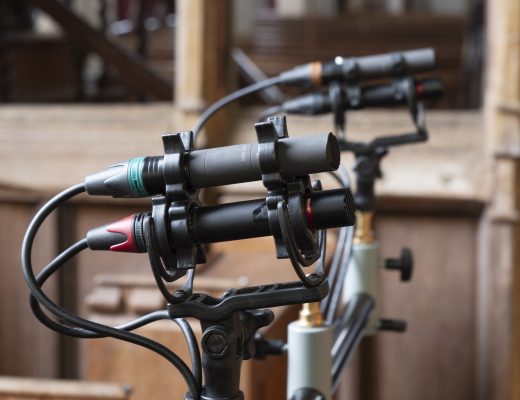

20 Comments
Very explicite test .
Thanh you!
Jean-Luc
Many thanks!
Cheers,
Roland
Thanks for the great review! I’ve been really looking for information on this, I’ve read it over and over again 🙂
18dBA self-noise, 14.2mV/Pa sensitivity, 20Hz -4dB. The specs alone aren’t the best(MKH 30), but considering the size, it’s really attractive and definitely up there. Can’t wait until it’s released.
What about the BD-10’s polar pattern, is it a single diaphragm with a truly symmetrical pattern?
Thanks Seung. As I said in the post the mic has ‘a pairing of 11mm diameter diaphragms one above the other with a waveguide to blend them: the polar pattern graph shows a very symmetrical result from this arrangement.’ In use the pattern certainly seems very symmetrical, but, of course, this is easier to see and measure in an anechoic chamber!
Cheers,
Roland
Great writeup. I purchased the HC15 a while ago and was hoping for a figure-8 microphone from them but bought the ATE308 last year. I don’t mind the bass roll-off since the ears can’t distinguish (so I’ve “heard”) stereo frequencies in that range very clearly, and many mixers cut out those frequencies in the sides to add supposed clarity.
Thanks Andrew. The ATE308 is evidently designed for one purpose only – to be clipped to a boom mic, and usually a shotgun mic – and for that its lack of bass isn’t a big issue (a high-pass filter would be needed all the more if it had more bass). But for MS where handling (and wind) noise isn’t such an issue (I use MS for field recording and music recording), then it is good to have a fuller frequency response (the ATE308 also lacks very high frequencies – a bit like the Schoeps MK8: not sure how much that matters): ideally, the M and S mics should be really well matched in terms of frequency response (as well as other parameters). Anyway, its good to have another fig 8 in the middle range of mics.
Cheers,
Roland
Do you think that a basket will be designed, or if by chance it might squeeze inside the nano shield to allow this to be used in a MS configuration?
Hi Conrad,
No idea if Rycote will design a new basket specifically for this mic, and not sure why given they already have a windshield suitable for stereo MS. The Nano Shield doesn’t have a lot of vertical height (85mm-ish) so it would need a new (double) lyre rather than using back-to-back clips, to get them close and central – to avoid getting the mics too close to the basket (with consequent increase in wind noise). I use my medium Cyclone for MS with the BD-10: there isn’t a stereo MS suspension option for a pair of 19mm diam mics, so I just have them in a mono cyclone with back-to-back clips and modified cabling.
Cheers,
Roland
Any update on price and availability? I’ve tried contacting Rycote twice and my case has been closed before they gave me an answer.
Hi Michael,
I don’t have any update on pricing, I’m afraid, but availability should be a matter of weeks as I understand (don’t hold me, or Rycote, to that!). Sorry not to be more help.
Cheers,
Roland
[…] new to making mics themselves) announce a small figure-of-eight mic in the form of the BD-10 (which I have tested previously), to form one of a family of seven mics; and Sennheiser soon followed with its announcement of the […]
[…] further the MKH 8030 in combination with the MKH 8040 cardioid as the mid mic, and throw the new Rycote BD-10 fig 8 and its cardioid (CA-08) sibling into the mix. Back at base, I’d decided that to […]
Just got a BD-10 and am very new to M/S recording. I’ve read that the positive side should be facing to the left. Can’t find any information about which side of the BD-10 is the positive side, is it the side with our without the dot?
It’s the side with the dot: it’s a fairly standard way of marking fig 8s. And, if new to MS, note that (for decoding purposes) it’s equally standard that the mid mic goes into channel 1 and the side (fig 8) mic into channel 2.
Cheers,
Roland
Thanks Roland. I suspected as much but was not made clear.
No problem: have fun with the BD-10 and mid-side recording!
Cheers,
Roland
Hi.
I already own a pair of CA-08 by Rycote and wanted to get the BD-10 and start my journey into DMS recordings.
As of now Rycote doesn’t off a dedicated Cyclone Kit for this setup. I was wandering if you also used your setup as a DMS rig for field recording, since this is my primary interest. If so, what windshield did you use and how did you put the mics in there?
Cheers,
Clemens
Hi Clemens,
I’m not a user of conventional DMS, though, as you will have seen, I often use a variant with two forward-facing mid mics of different polar patterns (I guess we should call this MMS?). The latter is easier to rig, obviously, and for such multi-mic rigs I tend to use my old Mk1 Rode blimp. As you will have noted there are various DMS Cyclone options, none of which are immediately suited to three such mics as the CA-08 x 2 and the BD-10. However, in a current thread on the Rycote Stereo Cyclone Kit 5, which I began on the Field Recording Facebook site, sound recordist Mark Cheffins posted some photos of his BD-10 + 2 x Rycote SDC DMS adaptation of a DMS Cyclone: he added clips and a new conn box, so it is quite doable and worth looking at his photos. Not sure what Rycote’s plans are in this regard or, indeed, what Radius Windshields plan (beyond an MS clip for the upcoming ALTO), so a bit of modification might be needed if you don’t want to wait and see.
Cheers,
Roland
Thanks for the quick response.
I already thought about modifying one of their kits. I will look into the group.
I contacted Rycote recently and they said that they are working on a solution but they didn’t provide any timeline.
Cheers,
Clemens
[…] see this post for my original review and tests of the […]